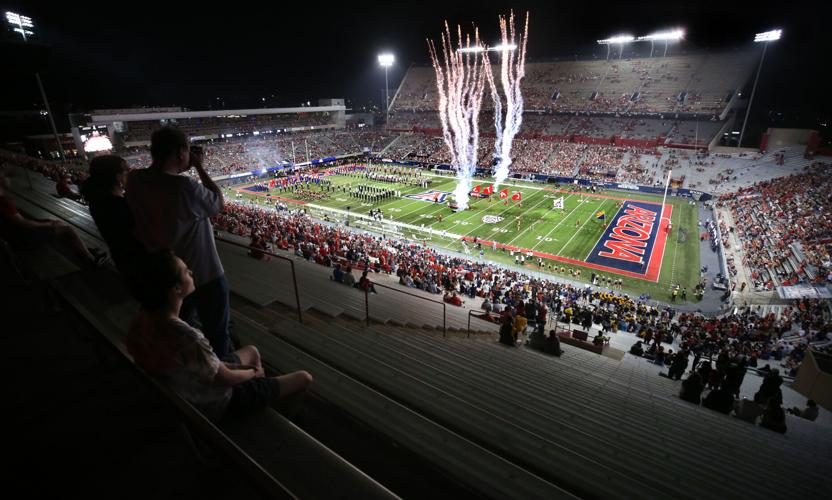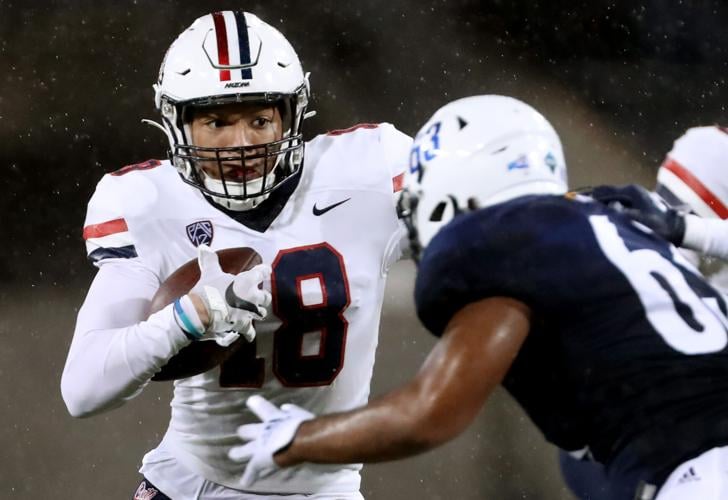The Star’s Michael Lev presents five storylines of interest as the Arizona Wildcats host UCLA on Saturday night at Arizona Stadium. Kickoff is at 7:30 p.m. The game will air on ESPN.
Arizona coaches recruited some of UCLA's top players
The Arizona coaching staff has deep connections to the Wildcats’ next opponent.
UA coach Jedd Fisch served as UCLA’s offensive coordinator in 2017 and finished that year as the Bruins’ interim head coach. UA quarterbacks coach Jimmie Dougherty tutored UCLA’s wide receivers the past four seasons.
Could Dougherty’s knowledge of the Bruins’ personnel and Chip Kelly’s scheme conceivably be a strategic advantage for Arizona, which hosts UCLA on Saturday night?
“Jimmie knows everything they're gonna do,” Fisch said.
He was kidding. Somewhat.
“He has a good feel for what they do,” Fisch said. “He can certainly share with us some of the things that he knows. But Coach Kelly knows that also, and we're not going to rely upon anything but film study and really recognizing what we’ve seen the last (five) weeks.”
Dougherty is listed in 247Sports.com's database as the lead recruiter of two of UCLA’s starting wideouts: Chase Cota and Kyle Phillips. Phillips leads the team in receptions (22), receiving yards (352) and receiving touchdowns (six).
Dougherty came to UCLA from Michigan with Fisch. They both came to work for Jim Mora, who would be fired before the last regular-season game. Fisch coached the 2017 finale as well as the Cactus Bowl — the latter after Kelly had been hired as Mora’s successor.
Kelly kept Dougherty on staff. Fisch’s stay in Westwood ended up being shorter than he expected. He became an assistant with the Los Angeles Rams the following season.
But Fisch left a legacy in his brief time as a Bruin. He was the lead recruiter for current UCLA quarterback Dorian Thompson-Robinson. The courtship began when Fisch was at Michigan.
“Coach Fisch and I have had a great relationship,” Thompson-Robinson told L.A. reporters. “He was a big part of why I chose UCLA.”
Fisch recalled recruiting Thompson-Robinson at Bishop Gorman High School in Las Vegas. Thompson-Robinson had to play receiver while biding his time behind star quarterback Tate Martell, who was a year ahead of him.
“He was the best wide receiver on the field,” Fisch said. “When they took a big lead, he then went in and played quarterback.”
Fisch lauded Thompson-Robinson’s dual-threat abilities. He has accounted for 1,368 yards of offense and 13 touchdowns.
Thompson-Robinson never played for Fisch. Thompson-Robinson enrolled in June 2018. Fisch’s main quarterback in ’17 was junior Josh Rosen, who had his best season and became the Cardinals’ first-round pick the following spring.
“Loved the kids,” Fisch said. “Enjoyed coaching Josh. Josh was drafted 10th overall. That was a pretty cool thing.”
Safeties have energized Wildcats
It doesn’t count as a turnover.
Maybe because it’s even better.
The Arizona defense has recorded two safeties this season. The Wildcats are one of only two teams in the country with that many. Virginia is the other.
Arizona got there first, notching safety No. 2 two Saturdays ago at Oregon. Like the one before it — in the opener against BYU — the play shifted the tenor of the game and enabled the Wildcats to mount a comeback.
“It's exciting,” said UA defensive line coach Ricky Hunley, whose group played an integral role in both safeties. “It is such a big momentum changer when you can get a big play, you can get a sack, you can get a safety, you can score on defense. Everybody can rally behind it — and then you get the ball back.
“That is one of the biggest plays in football. I hope we can get one every week.”
That’s a bit much to ask. But they do sometimes come in bunches. UMass twice registered three safeties in a game while Arizona defensive coordinator Don Brown was the head coach of the Minutemen.
Arizona’s single-game record is two. The most the Wildcats have had in a season is four (in 1941). They last had two in a season in 2019.
Both of this year’s safeties began with explosive plays by the defensive line. Against BYU, defensive tackle Trevon Mason busted into the backfield. He and linebacker Rashie Hodge Jr. then corralled running back Lopini Katoa in the end zone. Arizona scored on the subsequent possession. In just over a minute of game time, the Wildcats reduced their deficit from 21-3 to 21-13.
The safety against Oregon also took place in the third quarter. Defensive lineman Mo Diallo bull-rushed Ducks center Alex Forsyth. Mason and Kyon Barrs also helped to squeeze the pocket on Oregon quarterback Anthony Brown. Diallo sacked him. Arizona again followed the two-point play with a touchdown. The score went from 24-10 to 24-19.
“They all got great push,” Hunley said. “It just collapsed the pocket. It was beautiful. The quarterback stepped up and slid right into Mo’s arms.”
As mentioned, safeties don’t qualify as takeaways. But aside from fumbles or interceptions that are returned for touchdowns, they actually provide more of a boost than a simple turnover.
“You get points and you get the ball,” Hunley said. “And it's humiliating to the offense.”
Preparation paying off for Kenny Hebert

Arizona linebacker Kenny Hebert (18) heads up field after picking off Northern Arizona in the first quarter of their game at Arizona Stadium, Tucson, Ariz., September 18, 2021.
When NAU’s Jeff Widener threw a pass into the yawning chest of Arizona linebacker Kenny Hebert, it appeared to be a stroke of good fortune — an ill-advised throw by an overmatched quarterback to a defender he never saw.
But it wasn’t luck — unless you subscribe to the theory that luck is where preparation meets opportunity.
“It was a play we practiced. I got interceptions on it in practice,” Hebert said. “I knew it was an opportunity. He was dropping back, I watched him throw it and the next thing I knew the ball was in my chest. And yeah, I was trying to get to the end zone.”
Hebert returned the interception — the first of his football career, at any level — 16 yards to the NAU 24. It was one of a season-high three takeaways by the Wildcats, but it wasn’t enough to avert a stunning loss to the Lumberjacks on Sept. 18.
Hebert isn’t one to let setbacks get him down, though. He transferred to Arizona from Vanderbilt to try to finish his college career with a flourish. His final season is off to a promising start: He has 11 tackles and is tied for second on the team with 2.5 stops for losses, including a sack.
The latter was a product of preparation and perseverance as well. Hebert had come close to recording a sack in the first three games; he had a QB hit and a hurry in the opener vs. BYU. Then, in Game 4 against Oregon, Hebert finally got home, sending the Ducks’ Anthony Brown to the turf in the second quarter.
Hebert said he’s practiced harder after the near-misses and makes sure he gets a hand on the quarterback “every chance I get.”
“The biggest difference is just being prepared for that moment,” Hebert said. “You never know when that moment’s gonna come.”
Hebert knew what he was getting into when he transferred to Arizona. Armed with bachelor’s and master’s degrees from Vanderbilt, where he twice made the SEC Academic Honor Roll, Hebert wanted to play for Don Brown. The UA defensive coordinator saw in Hebert a potentially productive pass rusher blessed with speed and size (6-4, 231). He had all the attributes of a “Sam” linebacker in Brown’s system.
“It was an interesting conversation, really just about his scheme and where I would fit in with it,” said Hebert, who’s from New Orleans and attended the same high school, Holy Cross, as UA freshman linebacker Kolbe Cage.
“And about what they were building here. It's exciting.”
QB Jordan McCloud hit personal mark vs. Oregon

Arizona quarterback Jordan McCloud scrambles during the third quarter at Oregon on Sept. 25, 2021. McCloud threw multiple interceptions but earned the starting job for the following game against UCLA.
Quarterback Jordan McCloud’s first start as an Arizona Wildcat marked his 22nd collegiate appearance. In none of the previous 21 did he rush for as many yards as he did against Oregon.
McCloud set a career mark with 64 yards on nine carries against the Ducks. He also passed for 233 yards — his fourth-best total — and a touchdown. But McCloud’s five interceptions proved costly in a 41-19 defeat.
Below are McCloud’s top five passing and rushing outputs (including ties), along with the results of those games:
PASSING
Year/Opponent/Yards/Result
2020/UCF/ 404/L, 58-46
2020/E. Carolina/298/L, 44-24
2019/Cincinnati/267/L, 20-17
2021/Oregon/233/L, 41-19
2019/Temple/225/L, 17-7
RUSHING
Year/Opponent/Yards/Result
2021/Oregon/64/L, 41-19
2019/UConn/62 /W, 48-22
2019/S.C. State/56/W, 55-16
2019/E. Carolina/49/W, 45-20
2019/UCF/38/L, 34-7
2020/Houston/38/L, 56-21
Opponents steering clear of UA's Isaiah Rutherford

Brigham Young wide receiver Neil Pau'u (2) stiff arms Arizona cornerback Isaiah Rutherford (2) on his way to the end zone in the third quarter of the Vegas Kickoff Classic, Allegiant Stadium, Las Vegas, Nev., September 4, 2021.
Cornerback Isaiah Rutherford did not record a statistic in Arizona’s Week 4 game at Oregon, despite playing 57 defensive snaps. Yet he was the Wildcats’ second-highest-graded defensive player in that game, according to Pro Football Focus.
Such is the life of a corner. If you do your job right, the ball might not come your way.
Rutherford was targeted one time. The pass was not completed.
“It's a good thing and a bad thing,” Rutherford said. “Obviously I want to get some action in. But it's good that they’re only throwing at me one time and I was able to stop that too.”
They say playing cornerback is like being on an island. Rutherford must have felt like Tom Hanks’ character in “Cast Away” during Arizona’s Sept. 25 game in Eugene.
But Rutherford got used to it in high school, where he became a four-star prospect bound for Notre Dame. Perhaps college quarterbacks are catching on too: They have targeted Rutherford less and less. He has yielded a completion rate of just 33.3%.
“That's probably the one thing about the position,” Rutherford said. “If your name's not being called, you must be doing your job pretty good.”








